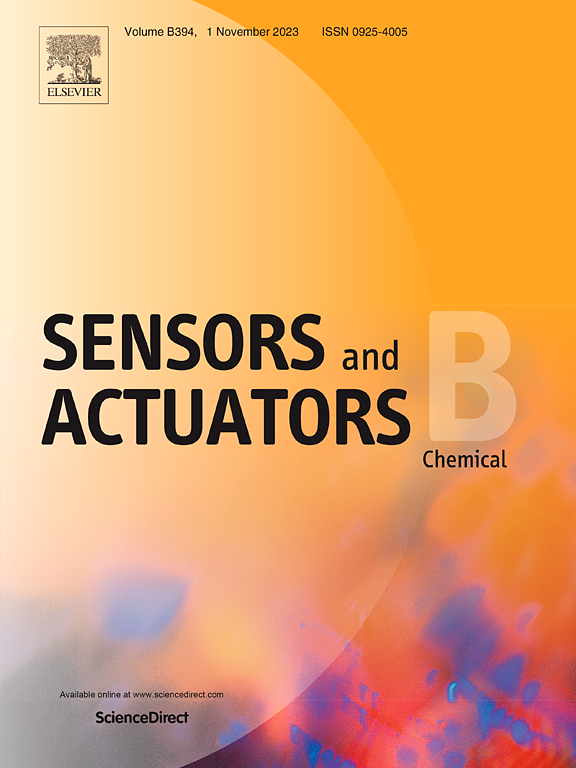花冠上盛开的花朵:一种用于溶酶体和线粒体极性双二维实时检测的新型光晕标签蛋白共轭比例荧光传感器
IF 8
1区 化学
Q1 CHEMISTRY, ANALYTICAL
引用次数: 0
摘要
跨多个细胞器同时检测,可以有效区分不同的细胞活动。然而,开发一种能够同时靶向多个细胞器的细胞监测器仍然是一个重大挑战。因此,我们首次设计了一种双荧光发射和多细胞器靶向(OT)蛋白共轭荧光传感器,X-TAG-Halo Tag-OT,能够进行精确的细胞分析。X-TAG在完整范围内对极性变化的比例荧光响应遵循玻尔兹曼函数,灵敏度高。值得注意的是,X-TAG-Halo Tag-Cox8a构建体可以同时靶向溶酶体和线粒体,产生嵌入线粒体“冠”内的溶酶体“花”的视觉上引人注目的比例荧光图像。通过采用“花冠”模式进行双细胞器分析,观察到自噬促进了溶酶体极性的增加(Δf Lyso = 0.2836至0.2944),同时降低了线粒体极性(Δf Mito = 0.2697至0.2584)。相反,在细胞凋亡过程中,溶酶体和线粒体极性均减弱(Δf Lyso, Mito = 0.2835 ~ 0.2734, 0.2688 ~ 0.2665)。此外,通过X-TAG-Halo Tag-Cox8a也可以高灵敏度地识别参与上述细胞活动的关键细胞器。X-TAG利用氮缩合增强了比值荧光发射的n→π*和π→π*跃迁,并使其具有通过含氮Halo Tag配体与ot融合的Halo Tag蛋白结合的能力,从而促进与多个细胞器的相互作用。这种通用性表明开发双多维荧光传感器的巨大潜力,为各种疾病的机制提供了新的见解。本文章由计算机程序翻译,如有差异,请以英文原文为准。
Flowers Blooming on the Crown: A Novel Halo Tag Protein-Conjugated Ratiometric Fluorescent Sensor for Dual Two-dimensional Real-time Detection of Lysosomal and Mitochondrial Polarity
The concurrent detection across multiple organelles can effectively distinguish diverse cellular activities. However, the development of a cellular monitor that can concurrently target multiple organelles continues to present a substantial challenge. Consequently, for the first time, we engineer a dual-fluorescence emission and multi-organelle targeting (OT) protein-conjugated fluorescent sensor, X-TAG-Halo Tag-OT, enabling precise cellular analysis. The ratiometric fluorescence response of X-TAG to polarity variations within an intact range follows the Boltzmann function with high sensitivity. Notably, the X-TAG-Halo Tag-Cox8a construct can concurrently target both lysosomes and mitochondria, producing a visually striking ratiometric fluorescence image of lysosomal “flowers” embedded within a mitochondrial “crown”. By employing the “flowers on a crown” pattern for dual-organelle analysis, it is observed that autophagy facilitates an increase in lysosomal polarity (Δf Lyso = 0.2836 to 0.2944), while decreasing mitochondrial polarity (Δf Mito = 0.2697 to 0.2584). In contrast, both lysosomal and mitochondrial polarity are diminished during apoptosis (Δf Lyso, Mito = 0.2835 to 0.2734, 0.2688 to 0.2665). Furthermore, the crucial organelles involved in the aforementioned cellular activities are also identified with high sensitivity by X-TAG-Halo Tag-Cox8a. X-TAG employs nitrogen condensation to enhance n→π* and π→π* transitions for ratiometric fluorescence emission and also endows it with the capability to bind to OT-fusion Halo Tag proteins via a nitrogen-containing Halo Tag ligand, thereby facilitating interactions with multiple organelles. This versality suggests significant potential for developing dual multidimensional fluorescent sensors, providing new insights into the mechanisms of various diseases.
求助全文
通过发布文献求助,成功后即可免费获取论文全文。
去求助
来源期刊

Sensors and Actuators B: Chemical
工程技术-电化学
CiteScore
14.60
自引率
11.90%
发文量
1776
审稿时长
3.2 months
期刊介绍:
Sensors & Actuators, B: Chemical is an international journal focused on the research and development of chemical transducers. It covers chemical sensors and biosensors, chemical actuators, and analytical microsystems. The journal is interdisciplinary, aiming to publish original works showcasing substantial advancements beyond the current state of the art in these fields, with practical applicability to solving meaningful analytical problems. Review articles are accepted by invitation from an Editor of the journal.
 求助内容:
求助内容: 应助结果提醒方式:
应助结果提醒方式:


